This article is written by Preeti Pallavi Jena, pursuing BSc.LLB (IPR Honors) from the school of law, KIIT University, Odisha. This article talks about the types of patent applications in India, the procedure for the grant, and the rejection of the patent.
Table of Contents
Introduction
A patent is an exclusive right that is given for 20 years to the owner who created a new product or invented something unique and novel. According to this right, no one else can use the new product or innovation once it is patented, for selling in the market or producing it in any place, or manufacturing the product without the permission of the patent holder. The patent right is not only given for products but also for the process by which a product is obtained. But the product or the process has to be new or consists of some innovative step in it. Example: Amazon’s Alexa.
The patent office is located in Kolkata, New Delhi, Mumbai, and Chennai. But the head office is in Kolkata. A patent is basically an invention and not a discovery. Registration of a patent application is compulsory in nature. A patent application is a written document that gives all the information of a patentable invention. An applicant can use methods for filing a patent application based on market situations, business matters.
Patentable invention
Every invention is not patentable in nature. For being patentable, the invention has to be new, non-obvious in nature and must follow the parameters made by the government of India. If an invention can create disturbances to the public like to the health of human beings, animals, and also to the environment, then those inventions cannot be patented.
After 20 years of availing the patent right, one has to renew it before its expiration period and if the renewal fees are not given then the patent will be revoked till it is restored again by the patentee, and once it gets revoked the patentee has no right to take action against the infringements made.
What can be patented?
- A process or method;
- A new composition;
- Research.
Who can file a patent application
- The person who first invented as per Section 6 of the Patents Act, 1970;
- Assignee;
- The legal representative of the estate.
Criteria for obtaining patent rights
Novelty
It means that the product or the process must be new and should not exist from before. The invention has been defined under the Indian Patent Act, 1970 under Section 2(1)(j) which says that the product which is new must have an inventive step in it and also should be capable of industrial application.
Inventive step
This must have technical advances or economic significance or else both of them. This makes it not obvious to Phista (a person skilled in the art). This has been defined under Section 2(1)(ja).
Industrial application
This means that the invention which is made should have some useful purpose and must have the ability to be used in the industry. For acquiring patentability, the invention needs to be useful enough in some fields.
Perks of getting patent in India
- A good market value or status. It also helps the owner to create a good relationship with the customers of the product and it attracts more customers, investors, and shareholders for his own product.
- If an investor gets patented, his confidence gets more strengthened for creating more ideas by knowing he will be the owner of his invention and even no can use it. They basically get the security of their product.
- If any other person applies for a grant of a patent of a similar product, then his grant will be rejected for the period of filing, which is 1 year.
- It stimulates the growth of the economy and it makes the products available in the market at a reasonable price.
- The owner gets full freedom for using, modifying the invention made by him, selling it, and also he gets the right to prevent others from using it but only in the territory where he gets the patent grant.
- Once your product is patented, you get the right to sue others for using the product or who try to infringe the rights because infringing someone’s patent right is a criminal offense.
- The patent right gives the owner the right to earn a good profit from the ROI (return on investment) which means he can earn money from the investments he made for his invention. This happens when the owner thinks that the product he created or originated is not giving the expected results he wanted, hence he gives it to a person who is successful enough for getting results out from it and he will earn some amount from the ROI.
Types of patent applications granted in India
- Ordinary Application;
- Convention Application;
- PCT International Application;
- PCT National Phase Application;
- Patent of addition;
- Divisional Application.
Ordinary Application
An ordinary application occurs with the whole specifications and also with the claims. This ordinary application is also called a non-provisional application and it occurs when the application of the patent holder is not filed in any conventional country or this application is also filed when the person filing has no priority to claim for patent grant. After the set up of the filing date of the application, the process of examination begins. This examination process will be done by the relevant patent office. An ordinary patent application must contain a written document with specifications, claims, and declarations, power of attorney, and filing fees. The ordinary patent application will get the patent grant only from the outcome of the examination conducted in the respective patent office.
Ordinary patent applications can be filed in India either with a provisional specification or with a complete specification. The specification is given with regards to the title of the invention, detail structures like the claims, drawing made. Provisional applications do not compulsorily contain claims but they must be followed with the complete specification within a period of 1 year.
Convention Application
It means when a person files a patent application for claiming a date on the basis of another application. The person can file for the application within a period of 12 months from the date of the first filing of a similar report in the convention country in the Indian patent office. It has been defined under Section 135 of the Act.
Mandatory requirements for convention patent application in India are as follows
- The name of the applicant, its address and particulars and also the nationality of the applicant or if there are many or more than one then applicants;
- The name, address, and also nationality of the inventors;
- Complete specifications, and details of the invention. The disclosing of the invention is the main condition of getting a patent;
- Details with regard to the priority date, application number, the title of the invention, etc;
- Documents supporting status if a small entity is claimed.
PCT International application
PCT is known as a Patent Cooperation Treaty and this treaty provides the right for getting patent protection at the international level for the new inventions or patent products they want to. This treaty also helps the office of the patent for making the right decision while granting a patent to someone. It also sees will that be beneficial for the society, like it is technical information which is new should be known or not to the public. If someone files one application for granting an international patent under the PCT, the person can also seek protection in many other countries at the same time for the new invention made, like one single application can seek protection in around 142 countries which is a great achievement.
PCT applications are governed by the patent cooperation treaty. It provides the application 31 months for filing in the international countries from the priority date and due to this the person gets more time for getting the value of the invention made by him.
PCT- National phase application
It is an application claiming for the priority of international filing date in the Indian patent office. After an application is made as per PCT, the first application can enter the national phase within a period of 31 months in India from the priority date made or from the international filing date. Whichever comes first on that it will enter. If an applicant has filed an ordinary application in India now and wants to file a PCT application then he can do so, within 1 year from the date of filing the ordinary application. It must be identical to the PCT application as available on WIPO. The amendments to any details of the patent application can only be made once a national phase is entered in India.
Mandatory requirements
- Name, address, particulars of the applicant;
- Name, address, the nationality of the inventor;
- A complete specification which should be in English with a certificate of translation;
- Details regarding the priority application like which country, date of filing, etc;
- Documents in support of the status claimed;
- Details of the PCT application.
Patent of addition
This has been mentioned under Section 54 of the Act. It is basically an extension of another patent. If an applicant has already been granted a patent for a product and the invention which is now made by the patentee is a modification or revised version of the previous invention, then he can apply for a patent of addition. But the invention must not consist of any substantial inventive step. This is made for a beneficial purpose because the person doesn’t need to pay the separate renewal fee for the patent of addition since the main patent is there in term and this patent of addition will expire with the main patent filed. It also uses the same applications which are used by the parent application.
Divisional application
If the application which is made by the applicant requires more than a single invention, then the applicant can himself divide it and file separately 2 or more applications for each invention. This is known as a divisional application. This is mentioned in Section 16 of the Indian Patents Act. Divisional applications can be filed when the parent application is pending.
Grant of patent applications
As per Section 43 of the Act, the patent can be granted to the person applied for or if it is a joint application then to the joint applicants. This grant of patent is only granted if the Controller gets satisfied with the order of the patent application and also it is not there in any contravention of any part or section of the Act. There must be a seal of the patent in the patent office and the register will keep a record of the date on which the patent was granted. Then a notice of the grant is published so that no one can try to infringe it and the relevant documents get opened for public inspection. Then a certificate is issued once the grant is made.
The procedure of grant of patent
Filing of the application
An applicant can file the application either for national or international filing. The initial filing is known as the priority filing after which further filings can be made within 1 year under the Paris Convention.
Examination of patent application
The request for the examination process needs to be done within 48 months of the date of filing of the application by the applicant. The patent office looks after all the formalities that need to be completed like the documents, filing fees must be given, etc.
Prior art search
The patent office does a search of the prior art, but this is not done in every country. In this search of the prior art, all the necessary technical information was made to the public knowledge at the timing of patent application filing. By using technical experts and examiners a search report is drafted which claims the merits of the invention along with the prior art.
Publication
The request for publication is not mandatory. It is made in the official journal. This publication of the patent application has to be done within 18 months of the date of first filing.
Grant/refusal of a patent
The Controller may either grant the patent application or reject it on the basis of the examination which is conducted.
Opposition
For a specific time period, the third party is allowed to oppose for grant of a patent if they want to, on the grounds that it does not qualify the patentability requirements.
Appeal
After the opposition, many offices may provide for appeal after the opposition procedure is over.
Rejection of patents in India
The rejection of patent applications is done under Section 15. It rejected around 1637 patent applications. The applicant is called by the IPO (Initial Public Offering) for clarifications but if he is unable to prove or give clarifications of the raised objections under Section 14. The application gets rejected under section 15 by the Controller.
Conclusion
Inventions are a very important source for the growth of patent process filing in India. An invention if unique and useful must be protected and the inventor must get encouraged by patenting it for inventing more and more and this will create growth in the economy of India. By giving protection, people can understand the value of the patents and also of the inventions made in India.
References
- https://www.intechopen.com/books/intellectual-property-rights-patent/case-study-on-rejected-patents-in-india
- https://patentbusinesslawyer.com/patent-filing-process-in-india/
- https://www.worldtrademarkreview.com/patent-opposition-process-india
- https://www.lrswami.com/page/types-of-patent-applications
- https://patentattorneyworldwide.com/in/different-types-of-patent-application/
- https://www.bananaip.com/ip-news-center/types-of-patent-applications/
- https://www.indiafilings.com/learn/types-of-patent-application/
- https://www.intepat.com/blog/patent/types-patent-application-india/
LawSikho has created a telegram group for exchanging legal knowledge, referrals and various opportunities. You can click on this link and join:
 Serato DJ Crack 2025Serato DJ PRO Crack
Serato DJ Crack 2025Serato DJ PRO Crack











 Allow notifications
Allow notifications



